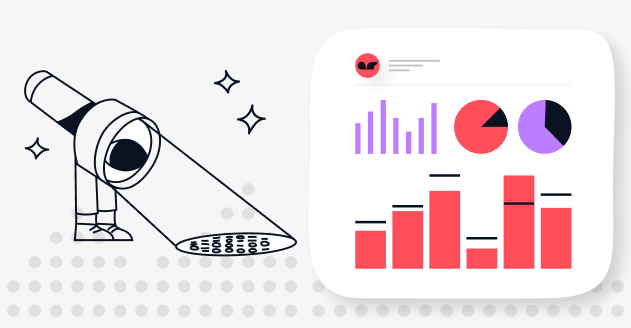Data Lineage In Data Catalogs
Learn about Data Lineage in Data Catalogs and Why It's Crucial?
Data management is like a puzzle, consisting of many interconnected pieces, each equally crucial for a complete and coherent picture. According to a study by Harvard Business Review, businesses that utilize robust data management practices can realize potential cost savings of up to 30%. Among the vital elements of data management, a data catalog serves as the cornerstone, providing an organized framework for all your data assets. Yet, even in the 21st century, only about 44% of companies have a data catalog in place, as per Gartner's report.
While having a data catalog is a step in the right direction, what makes it truly exceptional is the integration of data lineage. Data lineage lets you trace the journey of your data from its origin to its destination, much like a GPS for your data. In a world where data is expected to reach 175 zettabytes by 2025, as noted by IDC, understanding that journey is not just beneficial; it's imperative.
This article aims to dive deep into the importance of data lineage within data catalogs, explaining why it's not just a 'nice-to-have' but a critical component for businesses of all sizes.
What is Data Lineage?
Data lineage is the backstory of your data. It shows you where your data comes from, what changes it goes through, and where it ends up. This info helps you make better decisions, stay compliant with laws, and solve data issues quickly.
In a sense, data lineage is a roadmap that depicts the journey of data within an organization.
.jpeg)
Yet, in data catalogs, data lineage is different. It traces back relationships between dashboards, metrics, data tables, columns, and data tools.

5 Types of Data Lineage
Data lineage can be categorized into 5 main types:
Descriptive Data Lineage: Descriptive Data Lineage shows you the raw details about your data—where it's from, where it's going, and what happens to it along the way. It’s like the credits at the end of a movie, listing everyone and everything involved but without explaining why they matter.
Automated Data Lineage: Automated data lineage uses software to track and document your data's journey automatically, eliminating the need for manual tracking and reducing human errors. It's a time-saver that boosts accuracy.
Design Lineage: Design lineage is like the game plan for your data, outlining its intended path before it even starts its journey. It's the blueprint that details what should happen to the data from start to finish.
Business Lineage: Business lineage is geared towards the business side, not tech experts. It cuts out technical lingo to show how data directly affects business operations, like sales. It answers business-centric questions about data in a straightforward way.
Operational Lineage: Operational lineage provides a detailed look at the systems and processes your data goes through. Think of it as the tracking info for your data, showing each step from start to finish.
The Intersection of Data Lineage and Data Catalogs
1. Enhanced Navigation: Data lineage acts as your data's GPS. You don't just get a pinpoint location of your data, you also see the entire route it took to get there. This adds another layer to data discovery, making it easier to understand your data landscape.
2. Error Tracking: If you find a mistake, you can trace it back to where it originated. This lets you nip issues in the bud, making problem-solving quicker and more efficient, It's like having a rewind button for your data's journey.
3. Compliance: If you've a need to show to authorities that you're following laws or regulations, Data lineage provides an audit trail. This makes it easier to comply with rules like GDPR. It's like having receipts for every data transaction.
4. Informed Decisions: Data lineage gives you a historical context for your data. This means you can trust the data you're basing your decisions on. It's confidence in data form.
5. Resource Efficiency: Knowing the flow helps you find bottlenecks or redundancies in your data processes. You can optimize these to save time and resources. It's efficiency, but for data.
Why Data Lineage in Data Catalogs is Crucial
Below are a few reasons why data lineage is important in data catalogs -
Improved Data Quality
Data lineage helps you go Sherlock Holmes on your data. If something’s off, you can trace back to where the fault lies. Is it the source? Is it a particular transformation? You'll be able to pinpoint the problem area.
This is especially vital for companies that rely upon data quality in order to make efficient data-driven decisions.
Enhanced Data Governance
Data governance is basically making sure your data is up to mark and compliant with rules and regulations. Think of GDPR, the privacy law in Europe. With data lineage, you can easily show auditors where every piece of data came from, how it changed, and where it went, making compliance a walk in the park.
Streamlined Data Operations
Imagine cooking a dish. You have to chop, marinate, and cook. These are operations, similar to ETL (Extract, Transform, Load) in data. Knowing your data lineage can speed up these operations. You'll know which data to chop (extract), marinate (transform), and cook (load), and in what order.
Better Decision-making
No one likes making decisions in the dark. Data lineage in your catalog can be that flashlight in the dark, illuminating your path. It provides transparency, helping you understand the risks and make better, timely decisions.
Key Features to Look for in a Data Catalog with Data Lineage
When selecting a data catalog with data lineage, it’s a good idea to look out for some features:
1. Visualization Tools
Visualization tools in a data catalog with data lineage tools features offer more than just eye candy. They provide a functional roadmap for your data's journey. Just like a well-designed metro map simplifies a complex network of routes, these tools break down intricate data flows into easy-to-understand visuals.
They enable quick comprehension and immediate insights, helping you get to the core of complex data relationships without getting bogged down in endless spreadsheets or technical jargon. It's a way to simplify complexity and make data navigation accessible to everyone in your organization.
2. Integration Options
Your data catalog needs to gel seamlessly with your existing data infrastructure. It should fit effortlessly into your existing tech stack, be it cloud services, databases, or analytics tools.
Easy integration means less friction during setup and smoother data flow, saving you time and reducing the risk of errors. It streamlines the data management process, making your operations more efficient.
3. User-friendly Interface
A user-friendly interface is necessary to encourage wide adoption of the data catalog across your organization. The easier it is to navigate, the more likely team members ranging from data experts(data engineers, data analysts, etc.) to business folks will use it.
A straightforward interface breaks down barriers, making it simpler for everyone to tap into the data they need, which in turn fuels smarter business decisions.
4. Scalability
Scalability in a data catalog is crucial as data volumes inevitably grow. You'll want an enterprise data catalog that's sophisticated enough to manage your current needs but also robust enough to handle increased loads down the line.
Picking a scalable solution ensures that you won't outgrow your catalog too quickly, giving you peace of mind and a better return on your investment.
5. Good Security Features
Protecting your valuable data is crucial. A good data catalog should not only make data accessible but also prioritize its security. Comprehensive features like encryption, stringent access controls, and regular security updates are crucial. While ease of access is key, ensuring that access is limited to authorized personnel safeguards your data's integrity and your organization's reputation.
How to Implement Data Lineage in Your Data Catalog
5 steps to successfully implement data lineage in your data catalog -
1. Assess Your Needs
- Objective Setting: Understand why you want to incorporate data lineage. Whether you need it for regulatory compliance, enhancing decision-making, error tracking, or all the above.
- Scope Definition: Decide if you want data lineage for specific datasets or enterprise-wide data operations including data and metadata management.
2. Research & Choose the Right Catalog:
- Feature Check: Ensure that the data catalog tool you're considering supports data lineage functionalities.
- Compatibility: Make sure the catalog tool you select can integrate seamlessly with your existing systems and data sources.
3. Assemble the Right Team:
- IT Involvement: Engage your IT department or data specialists to ensure the correct setup.
- Stakeholder Input: Engage business users, data stewards, and analysts to capture their requirements and understand the data's business context.
4. Setup & Integration:
- Data Mapping: Identify and map out how data flows across your organization, from source to endpoint.
- Integration: Incorporate this mapped data flow into the catalog, ensuring it captures and visualizes the data lineage correctly.
5. Continuous Monitoring & Updates:
- Regular Check-ins: As data sources and processes change, regularly update the data lineage to reflect these changes.
- Feedback Loop: Establish a system for users to report inaccuracies or suggest improvements to maintain accuracy.
Conclusion
In this data-driven business space, the role of data lineage in catalogs is paramount. Serving as a clear roadmap, it shines a light on the data's journey, bolstering trust and transparency. This understanding of data's history and flow empowers businesses, enabling sharper, more informed choices, and ensuring that every data asset's potential is fully harnessed for optimal business outcomes.
You might also like
Contactez-nous pour en savoir plus



« J'aime l'interface facile à utiliser et la rapidité avec laquelle vous trouvez les actifs pertinents que vous recherchez dans votre base de données. J'apprécie également beaucoup le score attribué à chaque tableau, qui vous permet de hiérarchiser les résultats de vos requêtes en fonction de la fréquence d'utilisation de certaines données. » - Michal P., Head of Data.




.png)



